22.6 Managing Libraries
As your GroupWise DMS system grows and evolves, you might need to perform the following activities:
22.6.1 Editing Library Properties
After creating a library, you can change some library properties. Other library properties cannot be changed.
-
In ConsoleOne, browse to and right-click the Library object, then click to display the library Identification page.
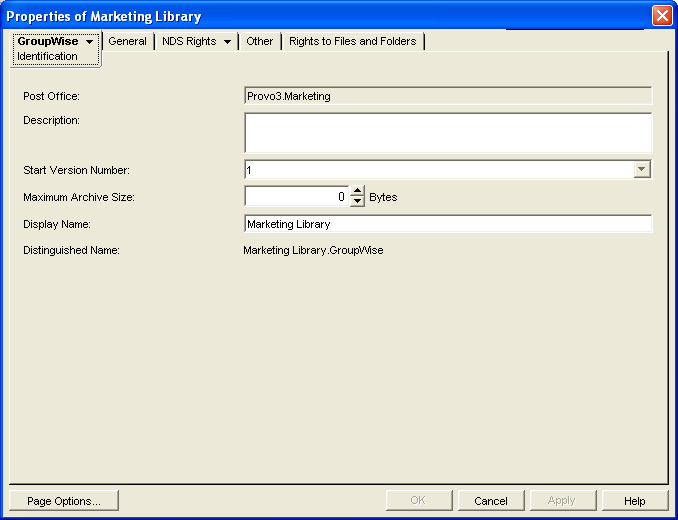
-
Change editable fields as needed. For information about individual fields, click .
-
Click > to display the Storage Areas page.
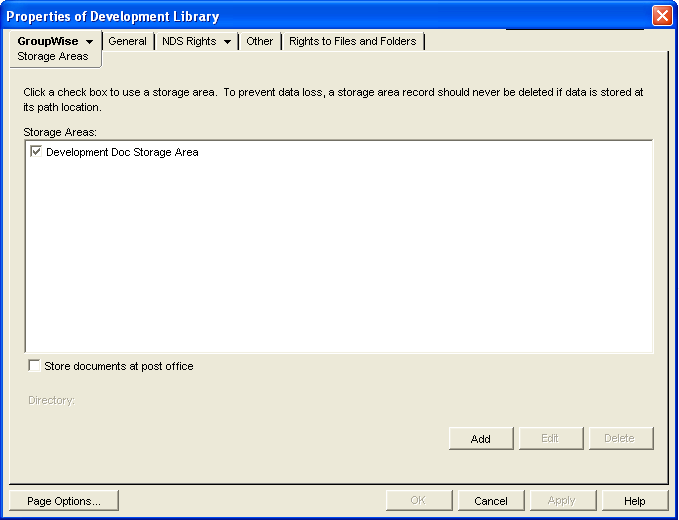
All document storage areas associated with the library are listed, no matter where they are located. On this page, you can add, move, and delete document storage areas. See Section 22.6.2, Managing Document Storage Areas.
-
Click > to display the library Rights page.
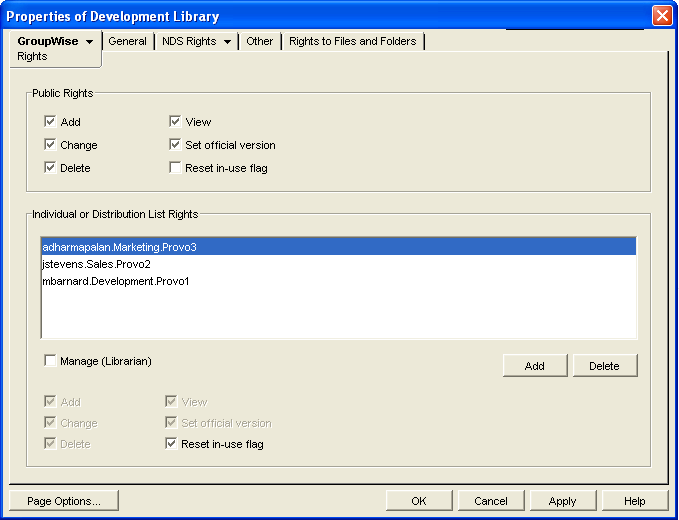
Public library rights granted to all users are selected in the box. The box shows any additional rights that have been granted to specific users. See Section 22.6.3, Managing Library Access and Section 22.6.4, Adding and Training Librarians.
-
Click to save changes to the library properties.
22.6.2 Managing Document Storage Areas
For a review, see Section 21.2, Document Storage Areas and Section 22.1.4, Deciding Where to Store Documents.
Typically, the initial document storage area for a library is set up when the library is created. Thereafter, you can create additional document storage areas as the library grows. You can move a document storage area to a location where more storage is available. You can delete a document storage area if it is no longer used.
Adding a Document Storage Area
To help you plan where to create the new document storage area, see Section 22.1.4, Deciding Where to Store Documents.
To create a new document storage area for a library:
-
In ConsoleOne, browse to and right-click the Library object, then click .
-
Click > to display the Storage Areas page.

Existing document storage areas are listed.
-
Click to create a new document storage area.
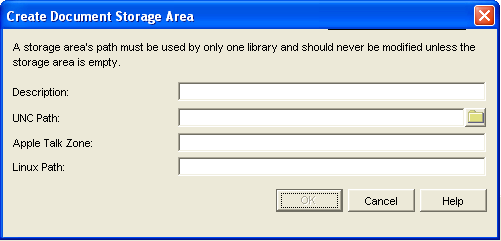
-
Provide a description for the document storage area.
-
Specify the UNC path to the directory where you want to create the document storage area.
If the directory does not exist, it will be created as the document storage area is set up.
As an alternative, you can specify an AppleTalk zone to store documents on an Apple* computer, or you can specify a UNIX path to store documents on a UNIX server. On Linux, you can specify a Linux path. The POA that will service the library must have direct access to the location you specify.
-
Click to create the new document storage area and add it to the list of storage areas for the library.
If you have multiple document storage areas selected in the list, new and modified documents could be added to any one of them.
-
If you want to stop storing documents in the previous document storage area, deselect it in the list.
-
Click to save the document storage area information.
Moving a Document Storage Area
You might choose to move a document storage area if it is close to exceeding the available disk space at its current location and you do not want to create an additional document storage area.
-
Stop the POA that services the library.
-
Copy the document storage area directory and all of its contents to the desired location.
-
Make sure that the POA has access to the new location so that it can read and write documents in the document storage area.
-
In ConsoleOne, browse to and right-click the Library object, then click .
-
Click > to display the Storage Areas page.

Existing document storage areas are listed.
-
Select a document storage area, then click Edit.
-
Provide the new location for the document storage area, then click OK twice to save the new document storage information.
-
Restart the POA.
Deleting a Document Storage Area
When you delete a document storage area, any documents in the document storage area are moved to other valid document storage areas for the library. If you want to move documents to a specific location before deleting the document storage area, see Section 23.1.3, Managing Groups of Documents.
To delete a document storage area:
-
In ConsoleOne, browse to and right-click the Library object that owns the document storage area, then click .
-
Click > to display the Storage Areas page.

-
Select a document storage area, then click .
-
Click to close the Storage Areas page
If the above steps are not successful in deleting a document storage area, perhaps because one or more documents were in use during the deletion process, you can use the Analyze/Fix Library action of Mailbox/Library Maintenance, with the and options selected, to finish cleaning up the deleted document storage area. For more information, see Section 28.0, Maintaining Library Databases and Documents.
22.6.3 Managing Library Access
Access to libraries is controlled by the rights users have to the Library object. By default, when a new library is created, all of the following rights are granted:
Table 22-4 Public Library Rights
There are a variety of reasons for which you might want to restrict certain library rights, including:
-
Your libraries are specialized by department and you want to restrict access to sensitive libraries, such as a payroll library.
-
Your libraries are distributed across multiple post offices and you want to restrict the scope of user searches to only the libraries they should use, thereby speeding up searches.
-
Your libraries are distributed across multiple servers and you want to minimize network traffic.
-
You have some users who should have more rights than other users to certain libraries.
To restrict public rights while granting individual rights:
-
In ConsoleOne, browse to and right-click the Library object, then click .
-
Click > Rights to display the Rights page.
-
In the box, deselect the rights that you want to remove from all users.
-
Click , then browse to and select the users who need to have rights to the library.
If the number is large, you might find it easier to create a distribution list for users who need rights. Then you can select one distribution list rather than multiple users. See Section 18.0, Creating and Managing Distribution Lists
-
In the box, select the users or distribution lists to grant rights to.
-
Below the list, select the rights that you want to grant.

In the first example, only one user is granted the Reset In-Use Flag right.
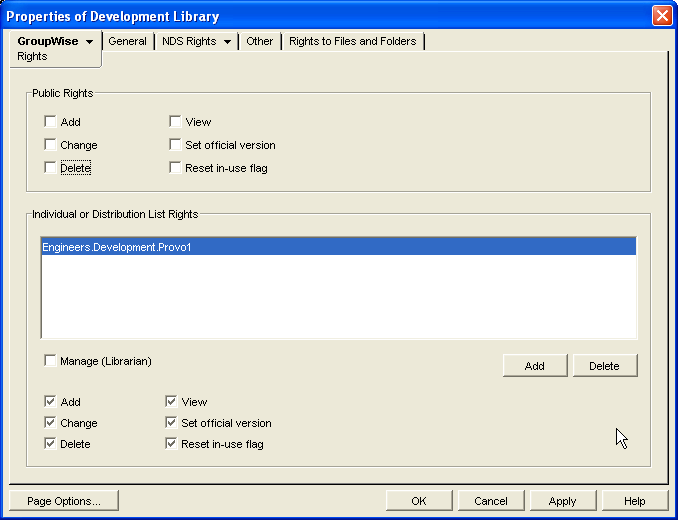
In the second example, only members of the Engineers group are granted any rights to the Development Library.
-
Click to save the updated library rights information.
22.6.4 Adding and Training Librarians
When you first create a library, you might for convenience assign yourself as the initial librarian. As library activity increases you can add librarians, and if desired, remove yourself as a librarian.
Understanding the Role of the Librarian
Keep in mind the following when assigning librarians:
Librarian Identity
Any GroupWise user with access to a library can be a librarian for the library. You can have multiple librarians for a single library. You can also assign a single user as a librarian for multiple libraries. Because being a librarian entails additional functions and rights in the library, you should choose responsible users as librarians.
Librarian Functions
A librarian can perform the following actions:
-
Check out a document without a copy.
-
Modify the properties of any document in the library.
-
Copy documents to another library.
-
Delete both documents and properties.
-
Reassign document creators and authors to handle orphaned documents
-
Reset a document’s status (change the In-Use flag).
-
View all activity log records of any document in the library.
-
Restore document BLOBs from backup.
-
Perform mass operations, such as moving, deleting, archiving, and changing properties.
-
Perform searches (but not full-text searches) on documents that are not available for searching by regular users.
-
Use GroupWise third-party APIs to generate reports on all library documents.
All operations available to a normal user are also available to a librarian, as long as the security requirement discussed under Librarian Rights is not compromised. The intention is that librarians can modify their own documents and document properties.
All actions taken by a librarian are written to a document’s activity log.
Unless the librarian’s own GroupWise user ID is in the or fields, a librarian cannot perform the following functions:
-
Open a document
-
View a document
-
Save a document
-
Check out a document with a copy
To help new librarians get started, you should explain these librarian functions to them. You can also refer new librarians to the “librarian users” topic in the GroupWise client help.
Librarian Rights
In addition to the six public rights, libraries also have a Manage right. When you grant the Manage right to a GroupWise user, you designate that user as a librarian. The Manage right gives the librarian full access to the properties of every document in the library. However, the Manage right does not grant the librarian direct access to the content of any document.
Because a librarian has full access to document properties, the librarian could add his or her own personal GroupWise user ID to the Author or Security field of a document, thus gaining access to the document’s content. However, a high-priority e-mail notification would automatically be sent to the original person listed in the Author field informing him or her of the action by the librarian. Therefore, document privacy is maintained.
The following table lists the various librarian functions, and whether an e-mail notification is sent if the function is performed.
Table 22-5 Librarian Functions
Mass operation notifications do not specify what action was taken by the librarian; they only specify that an action was taken.
The following table lists the document property fields that the librarian has rights to modify, and whether an e-mail notification is sent if the field is modified.
|
Property Field |
Notification? |
|---|---|
|
Subject |
No |
|
Author |
Yes |
|
Security (sharing list) |
Yes |
|
Document Type |
No |
|
Version Description |
No |
|
Custom Fields |
No |
|
File Extension |
No |
|
Official Version |
No |
|
Current Version |
No |
If you remove the Manage right from a user, you must manually deselect any rights that the user gained from being made a librarian that the user did not previously have.
Setting Up a Librarian GroupWise Account (Optional)
The Manage right is always in effect for those users who have been assigned as librarians. However, there might be times librarians want to act on their own accord without the possibility of seeing or modifying documents that belong to other users.
To allow users assigned as librarians to act as normal GroupWise users, you could create a single librarian account for a library and have users who need to perform librarian tasks log in using the librarian GroupWise account and password instead of their own.
If users assigned as librarians log in under a librarian GroupWise account, they do not have access to any documents they would normally have access to under their own accounts, except by altering the Author or Security fields.
Assigning Librarians
To add librarians to a library:
-
In ConsoleOne, browse to and right-click the Library object, then click .
-
Click > to display the Rights page.
-
Click , browse to and select the users that you want to assign as librarians, then click to return to the Rights page.
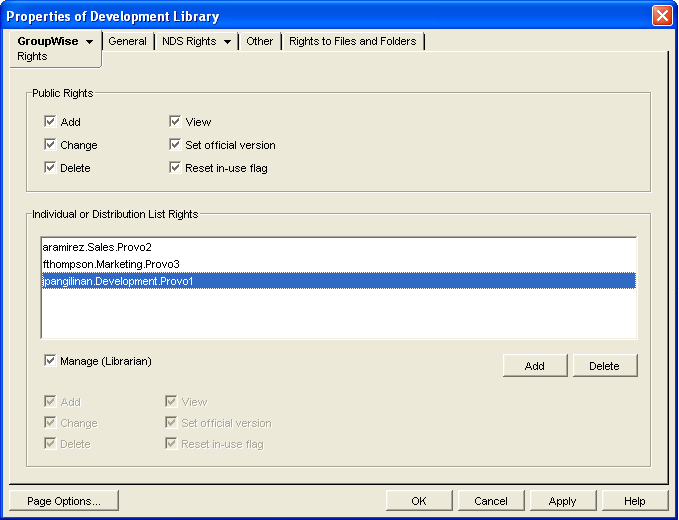
-
In the box, select the librarian users, select , then click to save the library rights changes.
22.6.5 Maintaining Library Databases
The Mailbox/Library Maintenance feature of ConsoleOne offers database maintenance features to keep your library and document databases in good condition. See Section 28.0, Maintaining Library Databases and Documents. It also helps you manage the disk space occupied by library and document databases and document storage areas. See Section 30.4, Reducing the Size of Libraries and Document Storage Areas.
When document creators or authors are removed from your GroupWise system, orphaned documents might be left behind. See Section 23.4.3, Handling Orphaned Documents.
To supplement your library maintenance procedures, you should back up your libraries and documents regularly. See Section 31.3, Backing Up a Library and Its Documents.
22.6.6 Moving a Library
You cannot move a Library object from one location to another in the eDirectory tree. To accomplish the equivalent, you would need to create a new library in the desired location, use a mass move operation in the GroupWise client to move the library’s documents from the old library into the new library, and then delete the old library.
As an alternative to moving the library, you can move just its document storage areas. See Moving a Document Storage Area.
22.6.7 Deleting a Library
You should not delete a library until you make sure that all documents still in the library are no longer needed.
-
In ConsoleOne, browse to and right-click the Post Office object that owns the library to delete, then click .
-
Click > to display the Libraries page.
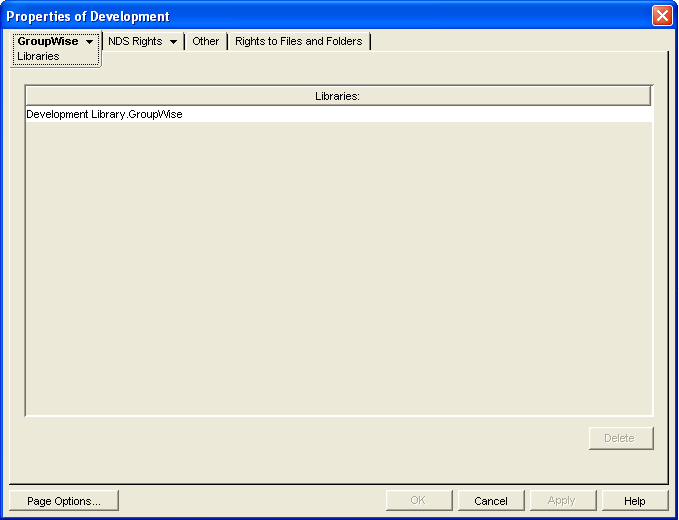
-
Select the library to delete, then click .
All document storages areas and documents are deleted along with the library.
-
Click to close the Libraries page and complete the deletion of the library.